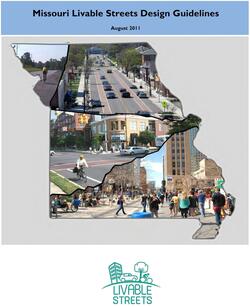Missouri Livable Streets Design Guidelines manual created
Submitted by Brent Hugh on Sun, 08/28/2011 - 5:17pm
The Missouri Livable Streets project has released a new manual explaining how communities can implement Livable Streets concepts (also known as Complete Streets).
The manual explains the benefits of Complete Streets, shows how Complete Streets policies can be implemented by a city or other agency (including examples of Complete Streets policies), and gives implementation and design guidelines for Complete Streets.
The manual says:
The Missouri Livable Streets Design Guidelines was created to provide guidance and references for Missouri communities to create Livable Streets. Livable Streets is a new way of looking at transportation. Its focus is on providing transportation corridors for motor vehicles and for people on foot, in a wheelchair, or on a bike.Communities with the Livable Streets have a higher quality of life and have experienced economic benefits as well. There are many Missourians that are unable to drive due to economic, age, physical impairments, or other barriers. By providing Livable Streets, theseMissourians can lead more productive, active lives. Livable Streets also address the needs of many ablebodied people that want active transportation options for commuting and for short trips.Livable Streets, also known as Complete Streets, consider the needs of all of the transportation users. For instance, Livable Streets sometimes provide sidewalks for pedestrians, scaled to the context of the built environment. Livable streets also consider universal design guidelines that provide space for those who use assistive devices. Livable Streets also consider bicyclists‘ needs as well. Livable Streets consider the needs of all transportation users whether they drive, bike, walk or wheel.Livable Streets help create livable communities. Through active transportation options, communities will be healthier, safer, and more successful.The steps to adopt a Livable Streets Policy are detailed in these guidelines. Additional information and resources are referenced. There is also a template for a model Livable Streets Policy resolution. As with all policies, public input and stakeholder participation will lead to a policy that meets the preferences of each community.Once a Livable Streets policy is in place, the community‘s entire transportation emphasis will shift from vehicles to a complete view of their transportation needs. The accomodation of all road users is goverened by multiple design guidelines. The key guidelines are referenced along with guidance on the combination of the different elements of a Livable Street.
Download the Missouri Livable Streets Design Guidelines (PDF file, August 2011)
Tags:
- News
- 2011
- adt
- bicycle
- Bike
- city
- community
- commuting
- complete streets
- economic benefits
- environment
- form
- guidelines
- links
- missouri
- missouri bicycle federation
- Missouri Livable Streets
- Missouri Tourism
- pedestrian
- pedestrians
- policy
- quality of life
- resolution
- resource
- sidewalks
- story
- streets
- transportation
- vacation
- Complete streets
- Cycling
- Cycling infrastructure
- Land transport
- Livable Streets
- Livable Streets
- Missouri
- Road transport
- Sustainable transport
- Technology
- Tourism
- Transport
- transportation
- Transportation planning
- Travel
- Urban studies and planning
- Walking
Join MoBikeFed's Advocacy Network
MoBikeFed is a statewide group of people like you, working together for better bicycling, walking, and trails in Missouri. When you join our advocacy network you receive occasional important advocacy alerts and bicycle, pedestrian, and trails news from around Missouri.
Working together we make a real difference! Join our advocacy network:
Working together we make a real difference! Join our advocacy network:
Related pages
Current topics...
Archives...
Want better bicycling and walking in Missouri?
We rely on the support of members like you. Please join, renew, or donate today.
- Home
- JOIN/DONATE
- News/Info
- Missouri Bicycling, Running, Trails
- Bicycle Skills and Safety
- Missouri Bike/Ped Law
- Clubs and Organizations
- Bike Shops
- Running Shops
- Bicycling, Running, Trails-related Businesses
- Ride, Run, Walk, Hike, Triathlon, and Events Calendars
- Bicycles on Amtrak
- Maps and Routes
- Trails and Trail Maps
- IBikeMO.org
- Planning a Missouri bicycle trip
- Gravel and Bikepacking Maps & Routes
- Bicycle & Touring Routes
- Advocacy
- Campaigns
- Our Legislative Platform
- Complete Streets
- Statewide Rock Island Trail
- Statewide Trail Vision - Quad State Trail
- Bicycle Friendly Missouri
- Walk Friendly Missouri
- Safe Routes to School
- MoDOT funding crisis
- High Priority Bike/Ped Project List
- Anti-harassment laws in cities & statewide
- Updating the basic bicycle law
- Our Vision for MoDOT
- Our Vision for MPOs/RPCs
- Our Vision for Cities & Counties
- Bicycle, pedestrian, trails plans across MO
- Protecting Vulnerable Road Users
- Vision Zero
- Missouri Trail Towns
- Store
- About


